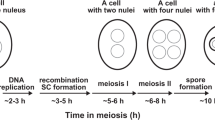Abstract
ACTIN, a major cytoskeletal component of all eukaryotic cells, is one of the most highly conserved proteins. It is involved in various cellular processes such as motility, cytoplasmic streaming, chromosome segregation and cytokinesis1,2. The actin from the yeast Saccharomyces cerevisiae, encoded by the essential ACT1 gene3–5, is 89% identical to mouse cytoplasmic actin and is involved in the organization and polarized growth of the cell surface6–9. We report here the characterization of ACT29 a previously undescribed yeast split gene encoding a putative protein (391 amino acids, relative molecular mass (Mr) 44,073) that is 47% identical to yeast actin. The requirement of the ACT2 gene for vegetative growth of yeast cells and the existence of related genes in other eukaryotes indicate an important and conserved role for these actin-like proteins. Superimposition of the Act2 polypeptide onto the three-dimensional structure9,10 of known actins reveals that most of the divergence occurred in loops involved in actin polymerization, DNase I and myosin binding, leaving the core domain mainly unaffected. To our knowledge, the Act2 protein from 5. cerevisiae is the first highly divergent actin molecule described. Structural and physiological data suggest that the Act2 protein might have an important role in cytoskeletal reorganization during the cell cycle.
Similar content being viewed by others
References
Pollard, T. D. & Cooper, J. A. A. Rev. Biochem. 555, 987–1035 (1986).
Drubin, D. G. Cell Motil. Cytoskel 15, 7–11 (1990).
Gallwitz, D. & Sures, I. Proc. natn. Acad. Sci. U.S.A. 77, 2546–2550 (1980).
Ng, R. & Abelson, J. Proc. natn. Acad. Sci. U.S.A. 77, 3912–3916 (1980).
Shortle, D., Haber, J. E. & Botstein, D. Science 217, 371–373 (1982).
Kilmartin, J. V. & Adams, A. E. M. J. Cell Biol. 98, 922–933 (1984).
Adams, A. E. M. & Pringle, J. R. J. Cell Biol. 98, 934–945 (1984).
Novick, P. & Botstein, D. Cell 40, 405–416 (1985).
Kabsch, W., Mannherz, H. G., Suck, D., Pai, E. F. & Holmes, K. C. Nature 347, 37–44 (1990).
Holmes, K. C., Popp, D., Gebhard, W. & Kabsch, W. Nature 347, 44–48 (1990).
Snyder, M., Elledge, S., Sweetser, D., Young, R. A. & Davis, R. W. Meth. Enzym. 159, 107–128 (1987).
Legrain, P. et al. Molec. Gen. Genet. 225, 199–202 (1991).
Mortimer, R. K. & Schild, D. Microbiol. Rev. 49, 181–212 (1985).
Greer, C. & Schekman, R. Molec. cell. Biol. 2, 1270–1278 (1982).
Huffaker, T. C., Hoyt, M. A. & Botstein, D. A Rev. Genet. 21, 259–284 (1987).
Adams, M. D. et al. Science 252, 1651–1656 (1991).
Elzinga, M., Collins, J. H., Kuehl, W. M. & Adelstein, R. S. Proc. natn. Acad. Sci. USA. 70, 2687–2691 (1973).
Haarer, B. K. & Pringle, J. R. Molec. cell. Biol. 7, 3678–3687 (1987).
Solomon, L. R. & Rubenstein, P. A. J. biol. Chem. 262, 11382–11388 (1988).
Aktories, K. & Wegner, A. J. Cell Biol. 109, 1385–1387 (1989).
Vandekerckhove, J., Deboben, A., Nassal, M. & Wieland, T. EMBO J. 4, 2815–2818 (1985).
Moreno, S. & Nurse, P. Cell 61, 549–551 (1990).
Surana, U. et al. Cell 65, 145–161 (1991).
Ghiara, J. B. et al. Cell 65, 163–174 (1991).
Langford, C. J. & Gallwitz, D. Cell 33, 519–527 (1983).
Chasman, D. I. et al. Genes Dev. 4, 503–514 (1990).
Dale, R. M. K., McClure, B. A. & Houchins, J. P. Plasmid 13, 31–40 (1985).
Devereux, J., Haeberli, P. & Smithies, P. Nucleic Acids Res. 12, 387–395 (1984).
Rothstein, R. J. Meth. Enzym. 101, 202–211 (1983).
Sherman, F., Fink, G. R. & Hicks, J. B. Methods in Yeast Genetics (Cold Spring Harbor Laboratory, New York, 1986).
McKnight, S. L. & Kingsbury, R. Science 217, 316–324 (1982).
Author information
Authors and Affiliations
Rights and permissions
About this article
Cite this article
Schwob, E., Martin, R. New yeast actin-like gene required late in the cell cycle. Nature 355, 179–182 (1992). https://doi.org/10.1038/355179a0
Received:
Accepted:
Issue Date:
DOI: https://doi.org/10.1038/355179a0
- Springer Nature Limited
This article is cited by
-
New insights into the regulation and cellular functions of the ARP2/3 complex
Nature Reviews Molecular Cell Biology (2013)
-
Actin organization and dynamics in filamentous fungi
Nature Reviews Microbiology (2011)
-
The ARP2/3 complex: an actin nucleator comes of age
Nature Reviews Molecular Cell Biology (2006)
-
A fungal actin-related protein involved in nuclear migration
Molecular and General Genetics MGG (1995)
-
RPK1, an essential yeast protein kinase involved in the regulation of the onset of mitosis, shows homology to mammalian dual-specificity kinases
Molecular and General Genetics MGG (1994)





